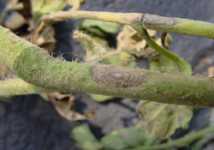Early Blight And Target Spot Management Tips

Early blight and target spot are a constant management challenge for tomato growers. Both are caused by fungal pathogens that under ideal conditions can defoliate plants and damage fruit, causing significant yield losses. Chemical control is the primary means by which growers manage both diseases, for which several fungicides are available. However, because of the specific nature of some active ingredients, there is a need to monitor both pathogens for the development of resistance by periodically reassessing the efficacy of fungicides in the field and evaluate new products for activity.
In 2008, field trials were conducted to test the effectiveness of several commercial and experimental fungicides for the management of early blight and target spot. Fungicide treatments were integrated into a standard weekly spray program consisting of copper (Cuprofix Ultra 40D, UPI; or Kocide 3000, DuPont Crop Protection), mixed either with mancozeb (Penncozeb 75DF, UPI) or chlorothalonil (Bravo Weatherstik, Syngenta Crop Protection). Applications were made to single bed, 24-foot plots with a CO2 back-pack sprayer calibrated at 40 psi for 60 or 90 gallons per acre. Trials were inoculated six to eight weeks after transplanting with a spore suspension of Alternaria solani and monitored for disease.
Spray programs that included Revus Top (mandipropamid and difenoconazole, Syngenta Crop Protection) combined with Endura (boscalid, BASF) or Tanos (famoxadone and cymoxanil, DuPont Crop Protection) alone or combined with Endura, controlled early blight and target spot better than the standard spray program. Endura alone or Quadris (azoxystrobin, Syngenta Crop Protection) gave moderate levels of control that were similar or slightly better than the standard, copper-mancozeb/chlorothalonil program. Several experimental materials from Syngenta Crop Protection, DuPont Crop Protection, and Bayer CropScience also gave superior control (data not presented).
For proper resistance management, it is important to take notice of the Fungicide Resistance Action Committee (FRAC) codes based on the mode of action to help growers rotate fungicides. For example, Tanos contains the active ingredients famoxadone (FRAC 11) and cymoxanil (FRAC 27) that inhibit fungal respiration by targeting different regions of the cytochrome bc1 complex. Therefore, none of the other FRAC 11 compounds, including all strobilurins, would be appropriate rotational partners with Tanos. Revus Top contains the active ingredients difenoconazole (FRAC 3), a sterol inhibitor, and a new compound, mandipropamid, (FRAC 40) that interferes with spore germination and cell wall deposition by inhibiting phospholipid biosynthesis. Both Tanos and Revus Top contain active ingredients that are also effective against late blight.
Actigard, from Syngenta Crop Protection, also controlled early blight and target spot. The active ingredient in Actigard, acibenzolar-S-methyl, has no direct effect on either pathogen, but stimulates plant defenses in a non-specific manner. Actigard has been shown to confer protection on numerous crops, including tomato, to a broad array of pathogens. Actigard is labeled for the control of bacterial leaf spot on tomato. However, these results make Actigard an attractive tool for the integrated management of foliar diseases common to tomato production in Florida. As with all pesticides, growers are reminded to read and follow the label instructions.









